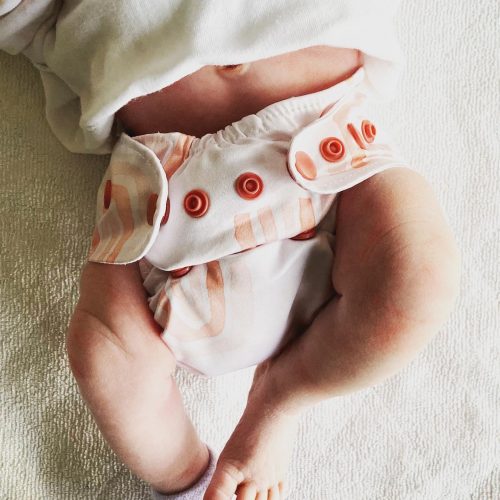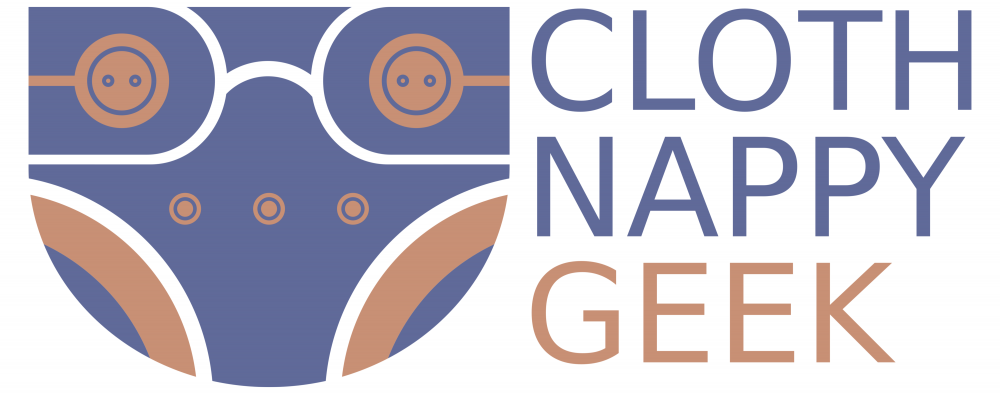
Having started dabbling in cloth with my second baby from around 2 weeks, and going full-time from 6 weeks, I thought I had a reasonable understanding of using cloth on a newborn. With my third baby (7lbs 8oz born) I used cloth right from the very first nappy. However unlike last time when I used a two-part system, I had a bunch of dedicated newborn nappies to try. These two things together has given me a very different experience, so these are the 10 things I wish I’d known:
- The urine output of a tiny newborn baby is a lot more than you’d expect. I think you hear a lot of talk about the poo output and the containment of this, but getting sufficient absorbency into such a tiny nappy was a real challenge. Whilst we didn’t have a poo explosion, we had many leaky nappies.
- Meconium doesn’t stain. Despite its rather toxic-looking tar appearance it is completely water-soluble. This means you don’t need to try remove any of it from your nappies, just pop them into the machine and wash as normal. Also cloth wipes will really help you clean up the meconium, so even if you don’t fancy using cloth nappies in hospital I’d really recommend taking your cloth wipes with you.
- A two-part system will really help you. All the various newborn nappies I’ve tried have been adorably cute, but without exception, after 2 hours the reliability was dubious. A two-part system (such as muslins), or a fitted newborn nappy is the best way to get a nappy you can trust (and added bonus is that they’ll provide better poo containment too).
- Again, muslins. They really are amazing. Affordable, fast-drying, absorbent, and pretty slim-fitting still. This would be my recommendation to anyone wanting to try cloth on a newborn. Don’t be put off by thinking that the folds are complicated (they’re not), I cover all that in my terry section.
- Even with a variety of different newborn nappies, getting a good fit was tricky. There is a huge variety in sizing across the brands. My baby was a fairly average weight, yet many were too big on her (sometimes for a number of weeks), whilst others fitted from birth but were outgrown within weeks. As a quick rule of thumb, look for nappies with rise poppers so at least you have some control over the sizing.
- Getting a good fit with the cord is hard. A short-term problem (maximum of two weeks, and was only 4 days for us this time) but a frustrating one if you really want to avoid disposables. If your baby’s cord has been cut short (ours was) this makes it even more difficult. If you know you want to use cloth right from birth then look for nappies that offer a cord cut-out – sometimes a U-shaped dip in the waistband, sometimes a popper to pull down the front a little. Elasticated waists are also an option as it allows you to pull the nappy down a bit. Both the Motherease Airflow and Petite Crown newborn wraps I mentioned above have elasticated waists.
- Washable change mats are a lifesaver with a newborn. Whilst all babies love to surprise us with mid nappy change toileting, newborns are especially prone to this, and not just wees either! Most washable change mats feature an absorbent side which just might save you from a full outfit change. I’d really recommend putting it in your hospital bag.
- This one sounds silly, but, fleece liners are bulky. Most of the newborn nappies I tried did not have a stay-dry layer. As I wanted my baby to feel dry I added a fleece liner. With the nappies being so small I had to fold the liners to make them fit, but they really add a surprising amount of bulk when on such a tiny baby. I found the Close Parent ones the best. Although they are large (hourglass shaped and give great coverage in a normal nappy) they are paper thin so were much better folded. Alternatively many people make their own fleece liners by cutting up a micro fleece blanket (I think Ikea do one for a reasonable price). One blanket is going to give you more than enough liners, so you could cut some much smaller to avoid the need to fold.
- I’ve mentioned that absorbency is an issue with so many newborn nappies. But what makes this especially difficult is that it is really hard to find a booster small enough for a newborn nappy. Many are too bulky if folded and will compromise the fit (giving you leg gaps and therefore leaks), if you need a fleece liner too then the problem is even worse. I found Kit and Kin boosters to be the best option as they’re short, narrow and slim. A cloth wipe folded in half is also a great option – and much cheaper!
- Newborn nappies are super cute but really not necessary or the best option.
You can also see a video version of this post, or find other useful information and reviews, on my YouTube channel.
